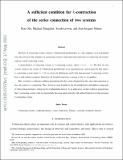A Sufficient Condition for k-Contraction of the Series Connection of Two Systems
Author(s)
Ofir, Ron; Margaliot, Michael; Levron, Yoash; Slotine, Jean-Jacques
DownloadAccepted version (1003.Kb)
Open Access Policy
Open Access Policy
Creative Commons Attribution-Noncommercial-Share Alike
Terms of use
Metadata
Show full item recordAbstract
The flow of contracting systems contracts 1-dimensional parallelotopes, i.e., line segments, at an exponential rate. One reason for the usefulness of contracting systems is that many interconnections of contracting sub-systems yield an overall contracting system.
A generalization of contracting systems is k-contracting systems, where k∈{1,…,n}. The flow of such systems contracts the volume of k-dimensional parallelotopes at an exponential rate, and in particular they reduce to contracting systems when k=1. It was shown by Muldowney and Li that time-invariant 2-contracting systems have a well-ordered asymptotic behaviour: all bounded trajectories converge to the set of equilibria.
Here, we derive a sufficient condition guaranteeing that the system obtained from the series interconnection of two sub-systems is k-contracting. This is based on a new formula for the kth multiplicative and additive compounds of a block-diagonal matrix, which may be of independent interest. As an application, we find conditions guaranteeing that 2-contracting systems with an exponentially decaying input retain the well-ordered behaviour of time-invariant 2-contracting systems.
Date issued
2022-09Department
Massachusetts Institute of Technology. Department of Mechanical Engineering; Massachusetts Institute of Technology. Department of Brain and Cognitive SciencesJournal
IEEE Transactions on Automatic Control
Publisher
Institute of Electrical and Electronics Engineers
Citation
R. Ofir, M. Margaliot, Y. Levron and J. -J. Slotine, "A Sufficient Condition for k -Contraction of the Series Connection of Two Systems," in IEEE Transactions on Automatic Control, vol. 67, no. 9, pp. 4994-5001, Sept. 2022.
Version: Author's final manuscript
ISSN
0018-9286
1558-2523
2334-3303